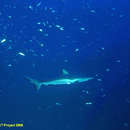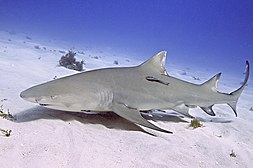en
names in breadcrumbs







Requiem sharks are sharks of the family Carcharhinidae in the order Carcharhiniformes. They are migratory, live-bearing sharks of warm seas (sometimes of brackish or fresh water) and include such species as the tiger shark, bull shark, lemon shark, spinner shark, blacknose shark, blacktip shark, grey reef shark, blacktip reef shark, silky shark, dusky shark, blue shark, copper shark, oceanic whitetip shark, and whitetip reef shark.
Family members have the usual carcharhiniform characteristics. Their eyes are round, and one or two gill slits fall over the pectoral fin base. Most species are viviparous, the young being born fully developed. They vary widely in size, from as small as 69 cm (2.26 ft) adult length in the Australian sharpnose shark, up to 5.5 m (18 ft) adult length in the tiger shark.[1] Scientists assume that the size and shape of their pectoral fins have the right dimensions to minimize transport cost.[2] Requiem sharks tend to live in more tropical areas, but tend to migrate. Females release a chemical in the ocean in order to let the males know they are ready to mate. Typical mating time for these sharks is around spring to autumn.[3]
Requiem sharks are among the top five species involved in shark attacks on humans;[4] however, due to the difficulty in identifying individual species, a degree of inaccuracy exists in attack records.[5]
The common name requiem shark may be related to the French word for shark, requin, which is itself of disputed etymology. One derivation of the latter is from Latin requiem ("rest"), which would thereby create a cyclic etymology (requiem-requin-requiem), but other sources derive it from the Old French verb reschignier ("to grimace while baring teeth").
The scientific name Carcharhinidae was first proposed in 1896 by D.S. Jordan and B.W. Evermann as a subfamily of Galeidae (now replaced by "Carcharhinidae").[6][7] The term is derived from Greek κάρχαρος (karcharos, sharp or jagged); and ῥί̄νη (rhinē, rasp), both elements describe the jagged, rasp-like skin.[8] Rasp-like skin is typical of shark skin in general, and is not diagnostic to Carcharhinidae.
The oldest member of the family is Archaeogaleus lengadocensis from the Early Cretaceous (Valanginian) of France.[9] Only a handful of records of the group are known from prior to the beginning of the Cenozoic.[10] Modern carcharinid sharks have extensively diversified in coral reef habitats.[11]
Requiem sharks are extraordinarily fast and effective hunters. Their elongated, torpedo-shaped bodies make them quick and agile swimmers, so they can easily attack any prey. They have a range of food sources depending on their location and species that includes bony fish, squids, octopuses, lobsters, turtles, marine mammals, seabird, other sharks and rays. They are often considered the "garbage cans" of the seas because they will eat almost anything, even non-food items like trash. They are migratory hunters that follow their food source across entire oceans. They tend to be most active at night time, where their impressive eyesight can help them sneak up on unsuspecting prey. Most requiem sharks hunt alone, however some species like the whitetip reef sharks and lemon sharks are cooperative feeders and will hunt in packs through coordinated, timed attacks against their prey.
The 60 species of requiem shark are grouped into 12 genera:[1]
† = extinct
 Blacktip reef shark, Carcharhinus melanopterus
Blacktip reef shark, Carcharhinus melanopterus  Spinner shark, Carcharhinus brevipinna, from the Gulf of Mexico
Spinner shark, Carcharhinus brevipinna, from the Gulf of Mexico  Galapagos shark, Carcharhinus galapagensis
Galapagos shark, Carcharhinus galapagensis  Lemon shark, Negaprion brevirostris, at Tiger Beach, Bahamas
Lemon shark, Negaprion brevirostris, at Tiger Beach, Bahamas  Blue shark, Prionace glauca
Blue shark, Prionace glauca Requiem sharks are sharks of the family Carcharhinidae in the order Carcharhiniformes. They are migratory, live-bearing sharks of warm seas (sometimes of brackish or fresh water) and include such species as the tiger shark, bull shark, lemon shark, spinner shark, blacknose shark, blacktip shark, grey reef shark, blacktip reef shark, silky shark, dusky shark, blue shark, copper shark, oceanic whitetip shark, and whitetip reef shark.
Family members have the usual carcharhiniform characteristics. Their eyes are round, and one or two gill slits fall over the pectoral fin base. Most species are viviparous, the young being born fully developed. They vary widely in size, from as small as 69 cm (2.26 ft) adult length in the Australian sharpnose shark, up to 5.5 m (18 ft) adult length in the tiger shark. Scientists assume that the size and shape of their pectoral fins have the right dimensions to minimize transport cost. Requiem sharks tend to live in more tropical areas, but tend to migrate. Females release a chemical in the ocean in order to let the males know they are ready to mate. Typical mating time for these sharks is around spring to autumn.
Requiem sharks are among the top five species involved in shark attacks on humans; however, due to the difficulty in identifying individual species, a degree of inaccuracy exists in attack records.